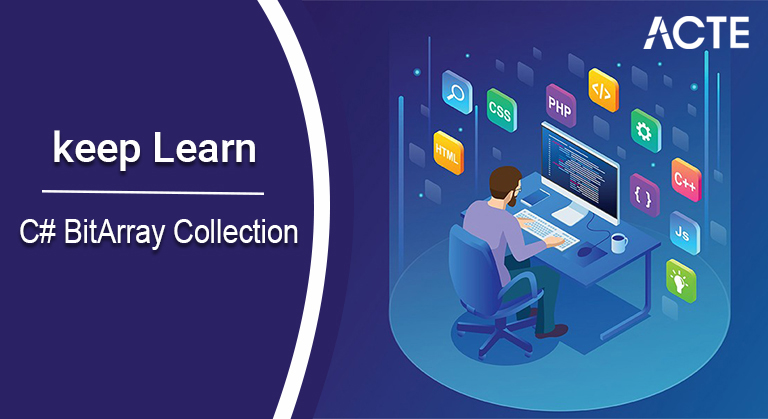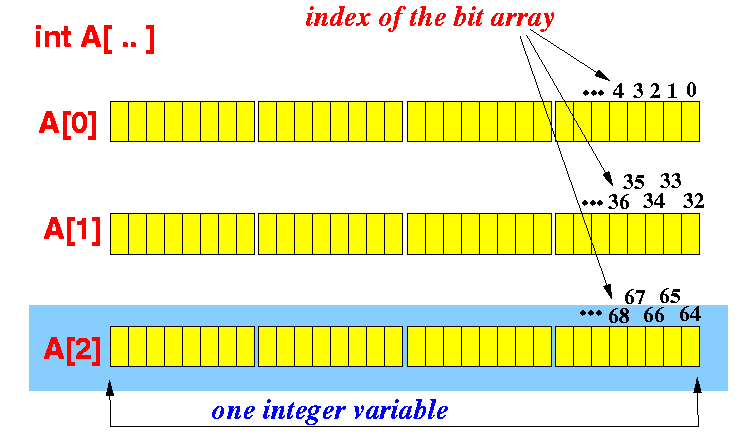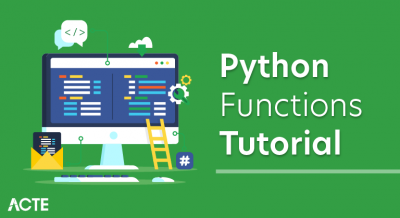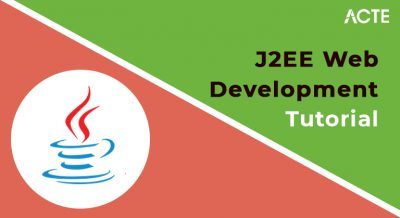
- Introduction to C# BitArray
- BitArray class methods and properties
- Definition of C# BitArray
- Basic operations
- Bit Manipulation with the BitArray
- Executed Collection Interfaces
- Constructors
- Perusing and Writing BitArray Content
- Pros and cons
- About BitArray
- Gets or sets the number of elements in BitArray
- How image recognition works
- Conclusion
- A bit array is a mapping from a few domain (nearly continually quite a number integers) to values withinside the set . The values may be interpreted as dark/light, absent/present, locked/unlocked, valid/invalid, et cetera. The factor is that there are best viable values, so that they may be saved in a single bit. As with different arrays, the get entry to to a unmarried bit may be controlled with the aid of using making use of an index to the array.
- Assuming its size (or length) to be n bits, the array may be used to specify a subset of the domain (e.g. ), in which a 1-bit suggests the presence and a 0-bit the absence of a variety of withinside the set. This set statistics shape makes use of approximately n/w phrases of space, in which w is the variety of bits in every gadget phrase.
- Whether the least considerable bit (of the phrase) or the maximum considerable bit suggests the smallest-index variety is essentially irrelevant, however the former has a tendency to be preferred (on little-endian machines).
- OR may be used to set a piece to one: 11101010 OR 00000100 = 11101110
- AND may be used to set a piece to zero: 11101010 AND 11111101 = 11101000
- AND collectively with zero-checking out may be used to decide if a piece is set:
- 11101010 AND 00000001 = 00000000 = 0
- 11101010 AND 00000010 = 00000010 ≠ 0
- XOR may be used to invert or toggle a piece:
- 11101010 XOR 00000100 = 11101110
- 11101110 XOR 00000100 = 11101010
- NOT may be used to invert all bits.
- NOT 10110010 = 01001101
- BitArray banners = new BitArray(16);
- BitArray banners = new BitArray(16, valid);
- BitArray banners = new BitArray(16, bogus);
- flags[0] = valid;
- flags.Set(1, valid);
- BitArray banners = new BitArray(16);
- flags.SetAll(true);
- Despite their simplicity, bit arrays have many distinct advantages over other data structures for the same problem. They are very compact. Other data structures do not allow n independent data to be stored in n / w words. They allow you to store and manipulate small arrays of bits in register files for extended periods of time without accessing memory. With the ability to take advantage of bit-level parallelism, limit memory access, and maximize data cache utilization, many other real datasets, even those that are progressively more efficient.
- Often outperforms the data structure of. However, bit arrays are not all solutions. Specifically, without compression, a sparse set (a set with fewer elements than a range) would result in a temporally and spatially wasted set data structure. For such applications, you should consider compressed bit arrays, judy arrays, trials, and even Bloom filters instead. Accessing individual items can be expensive and difficult to express in some languages.
- Random access is more common than sequential access, and if the array is relatively small, a byte array may be more suitable for byte-addressed machines. However, word arrays are probably not justified because they have very high storage overhead and incur additional cache misses unless you only have to specify word addresses on your machine.
- C # programming with an image editor, this is a Windows Phone application, a very big project compared to the apps currently available for smartphones. Unfortunately, when we showed it to so-called technicians in 2013, we haven’t made it public yet, as people never respect the value of this software.
- Six months later, I took a digital imaging course in my major and taught me behind the scenes of what I wrote earlier as code.
- There were many performance issues with this code and it took quite a long time to parse the 8MP image. It was rejected without touching the code after the demo (although it wasn’t actually rejected because of its performance).
- A few years later, I was working on another performance issue with another software, and one of my conclusions was to change some data structures.
- When I reopened the old image editor I wrote in 2013, I found that it mainly uses arrays and lists as collection data structures. I’ve been thinking about how to improve it and which data structures are best suited for this type of work.
Introduction to C# BitArray
The BitArray class maintains a compact array of bit values represented as Boolean values. Used when you need to store bits, but you do not know the number of bits in advance. You can access the elements of the BitArray collection using a zero-based integer index.
Assembly:
System.Collections.dll
Manages a compact array of bit values, which might be represented as Booleans, in which proper shows that the bit is on (1) and fake shows the bit is off (0).
BitArray class methods and properties
The following table lists some of the commonly used properties of the BitArray class-
Count – Gets the number of elements contained in BitArray.
IsReadOnly- IsReadOnly Gets a value that indicates whether the BitArray is read-only.
Item – Gets or sets the value of the bit at the specified position in BitArray.
length – Gets or sets the number of elements in BitArray.
Definition of C# BitArray
Basic operations
Although maximum machines aren’t capable of cope with character bits in memory, nor have commands to control unmarried bits, every bit in a phrase may be singled out and manipulated the use of bitwise operations. In particular:
To gain the bit masks wanted for those operations, we will use a piece shift operator to shift the no 1 to the left with the aid of using the best variety of places, in addition to bitwise negation if necessary.
Bit Manipulation with the BitArray
The forty-second piece of the C# Fundamentals instructional exercise looks at the utilization of the BitArray class. This sort of assortment can be utilized to hold an exceptionally enormous series of pieces that can be controlled either freely or altogether as a whole gathering.
The BitArray Collection
The BitArray assortment can hold enormous gatherings of Boolean qualities or touch fields. It is like different assortments that have been talked about in the C# Fundamentals instructional exercise. In any case, the substance of the assortment are not protests yet Boolean qualities. This implies that the conduct of the class varies somewhat.
Executed Collection Interfaces
The BitArray assortment executes the properties and strategies for the ICollection interface. This conduct is portrayed in the prior Collection Interfaces article. The remainder of this article portrays the extra usefulness given by BitArrays.
Constructors
The BitArray class is uncommon in that it doesn’t give a parameterless constructor. BitArrays assortment should be completely introduced while started up utilizing one of six constructors. Each populates the substance of the assortment in an unexpected way. The most straightforward constructor makes a BitArray containing a few Boolean qualities that are altogether bogus. The quantity of pieces required is passed as a number contention.
The BitArray class is found in the System. Assortments namespace so to execute the models, add utilizing System. Assortments; to the source code.
This constructor can be stretched out by passing a second, Boolean worth. For this situation, the made BitArray is measured by the number boundary and every component in the assortment is set to the Boolean worth.

Perusing and Writing BitArray Contents
Perusing Individual Bits
Single pieces can be extricated from a BitArray utilizing a record number attached to the assortment name inside square sections. The class additionally gives a Get strategy that acknowledges the file as a boundary and returns the worth of the piece at the predetermined position. Every strategy is exhibited beneath:
Composing Individual Bits
You can set and clear individual pieces in a BitArray. Likewise with perusing the singular pieces, there are two methods for doing as such. First and foremost, the record worth might be annexed to the assortment name and the worth of a piece relegated straightforwardly. Besides, you can utilize the Set technique. This technique acknowledges a number boundary for the file of the thing to change and a Boolean demonstrating the new worth. The accompanying model shows the two strategies:
Composing Multiple Bits
Frequently you will need to set or get all free from the pieces inside a BitArray. This can be accomplished utilizing the SetAll technique. The technique requires one contention holding the new incentive for each piece inside the assortment.
BitArray Length
As the BitArray class carries out ICollection, it incorporates the Count property that profits the quantity of pieces in the assortment. Notwithstanding this read-just property, BitArray gives a Length property that can be utilized to both solicitation the quantity of things in the assortment and to change the length. At the point when the Length property is set, the size of the BitArray might increment or diminishing. Assuming that the new length is more modest than the current number of things, the assortment is shortened with all sections at records equivalent to or higher than the new length being forever deleted. In the event that the new length is bigger than the current number of things, new things are attached to the BitArray. Each extra piece is at first bogus.
Pros and cons:
About BitArray:
The BitArray class maintains a compact array of bit values represented as Boolean values. Here, “true” indicates that the bit is on (1), and “false” indicates that the bit is off (0). Used when you need to store bits, but you do not know the number of bits in advance. You can access the elements of the BitArray collection using a zero-based integer index. BitArray Class Methods and Properties.
Gets or sets the number of elements in BitArray
The following table lists some of the commonly used methods in the BitArray class.
public BitArray And (BitArray Value); – Performs a bitwise AND operation on the element in the current BitArray for the corresponding element in the specified BitArray.
public bool Get (int index); – Gets the value of the bit at a specific position in the BitArray.
public BitArray Not (); – Reverses all bit values in the current BitArray and changes the element set to true to false and the element set to false to true.
public BitArray Or (BitArray value); – Performs a bitwise OR operation on the elements in the current BitArray for the corresponding elements in the specified BitArray.
public void Set (int index, bool value); – Sets the bit at a specific position in the BitArray to the specified value.
public void SetAll (boolean value); Set all bits of the- BitArray to the specified value.
public BitArray Xor (BitArray value); – Performs a bitwise exclusive OR operation on the current BitArray element for the corresponding element of the specified BitArray.

How image recognition works
You know that C # is excellent. It provides multiple ways to work with images. A very well-known feature is the ColorMatrix class. It makes it very easy to adjust the RGB, hue, saturation and brightness of an image.
Grayscale image
Grayscale image is typically required for image recognition algorithms or certain image operations such as sharpening and blurring, and thresholds must be set. Next, a common mistake is to store the bits of the threshold image in an array that accepts bytes. Byte can take a value from 0 to 255, but it actually contains both all black and all white pixels, so for a thresholded image, the value you actually set. Is 0 and 1. After operating with bit operations such as, XOR, OR, NOT. Here is the real need when using BitArray.
C #
BitArray has been in existence since .NET 1.1 and has multiple constructors, so it can accept Boolean arrays, byte arrays, integer arrays, and even other BitArrays. However, its advantage is that it has built-in functions for operations such as NOT, AND, OR, and XOR. Most of these functions have been optimized to improve performance.
BitArray collection in C #
The BitArray collection handles a compact array of bit values. These bit values are represented as Boolean values. Where true indicates 1 and false indicates 0.
BitArray Collection Constructors
The various constructors and their descriptions are shown below.
BitArray (BitArray)- This constructor contains a new instance of the BitArray class that contains the bit values copied from the specified BitArray collection. Initialize.
BitArray (Boolean [])- This constructor initializes a new instance of the BitArray class that contains the bit values copied from the specified Boolean array.
BitArray (byte [])- This constructor initializes a new instance of the BitArray class that contains the bit values copied from the specified byte array.
BitArray (Int32)- This constructor initializes a new instance of the BitArray class that is initially set to false and can hold a specified number of bit values. BitArray (Int32, Boolean) This constructor initializes a new instance of the BitArray class that can hold the specified number of bit values set at the first specified value.
BitArray (Int32 []) – This constructor initializes a new instance of the BitArray class that contains the bit values copied from the specified 32bit integer array.
Conclusion
The BitArray class deals with a smaller exhibit of spot esteems, which are addressed as Booleans, where genuine shows that the piece is on (1) and bogus demonstrates the piece is off (0). It is utilized when you really want to store the pieces yet don’t have the foggiest idea about the quantity of pieces ahead of time.






